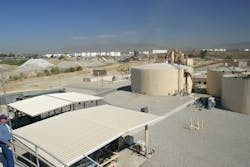AECOM and Veolia Help Advance Wastewater Treatment Microgrid in Southern California
The city of Rialto, California, is moving ahead with plans to build a microgrid at a wastewater treatment plant with support from Veolia and AECOM.
AECOM was selected to design the $8.2 million microgrid, which is expected to include a 360-kW reciprocating engine that would run on biogas, a 1.6-MW photovoltaic system and a 2.5-MWh lithium ion battery that could run for four hours before needing to be recharged.
The generating units would provide all the facility’s electric needs, and the microgrid will allow the plant to run when there are power outages.
“As California and the rest of the country contend with a growing number of natural disasters linked to climate change — including widespread power outages and brownouts caused by heat waves and wildfires — the resilience offered by a microgrid power source is more important than ever,” Rialto Mayor Deborah Robertson said March 17.
The wastewater treatment plant is run through a partnership between Rialto Water Services and Veolia North America.
Microgrids increasingly used in wastewater treatment
Microgrids are increasingly being used at wastewater treatment plants, partly to save money and partly to prevent raw sewage from entering waterways during power outages.
Four years ago, Public Service Electric and Gas started operating a wastewater treatment microgrid in New Jersey, and last year the McKinleyville Community Services District in northern California selected Ameresco to build a $2 million microgrid at a wastewater treatment plant.
Microgrid to cut utility bills
Rialto, a city of about 100,000 east of Los Angeles, expects the project will cut the treatment plant’s utility bills. The facility’s annual electric bills are about $772,000 and its natural gas charges are about $91,000, according to a Feb. 23 presentation to the city council.
Instead of flaring biogas at the plant, the biogas will be used to run a cogeneration facility that will also provide heat for the plant’s anaerobic digesters.
The planned system will avoid the use of natural gas in two ways. First, natural gas must be mixed with the biogas to burn it off, according to the city. Second, the natural gas currently used to heat the anaerobic digesters will no longer be necessary.
The project is expected to reduce carbon dioxide emissions from the treatment plant by about 600 million metric tons a year.
Rialto expects it will be able to sell excess energy from the project into the power grid.
Anticipating $1.9 million in incentives for the project, Rialto forecasts $460,000 in annual cost savings for the city, according to a feasibility study prepared by SourceOne, a Veolia Energy unit.
Construction likely in 2022
After the design process is finished, construction on the project is expected to start in early 2022 and be completed about a year later.
AECOM beat out Arup and Jacobs Engineering for the contract to design the microgrid. Under the contract, AECOM could go on to build the microgrid.
Interested in microgrids? Join us for Microgrid 2021: The World Awakens to Microgrids, a virtual conference hosted by Microgrid Knowledge. Participation is free for those who register in advance.







